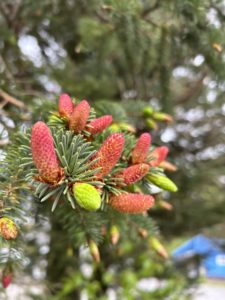

The Question:
Hello Scientist,
On a mission to make spruce tip cookies and spruce tip syrup, we went out to collect the abundant green spruce tips from nearby spruce trees. While we were out picking spruce tips, Arcadio (age 6) and Jase (age 6) pointed out to me that there are red spruce tips. They continued to ask me why they were red, and I did not have an answer for them. My question for you is why are certain spruce tips red this year?
-Amber Nolan
The Answer:
Hi Amber,
That is a great question. These red spruce tips you mention are not spruce tips at all. They are the immature male spruce cones of the spruce tree. They are easy to confuse with a spruce tip due to the similar size, shape, and location of growth. As these immature male spruce cones develop, they will begin to fill with pollen that will later be released.
Sitka spruce trees start to produce their cones between 20 and 40 years of age. These trees are monoecious, meaning that they house both male and female reproductive organs in one individual tree. The male strobili, or spruce cones, are found lower in the tree; whereas the female strobili are found towards the top of the tree (Harris, n.d.).
While spruce trees produce spruce tips annually, spruce trees do not always produce male pollen cones. Male pollen cone production is cyclical. Certain trees go through production in peaks and troughs. The peak is known as a mast year. The reason that you may not have noticed these immature, red cones in the past is because it may not have been a mast year. A study performed by Roland & Stehn, 2022, shows that cone production is dependent on climate conditions. They found that in Alaska, the last mast year was in 2020. The trees that they were studying in 2021 did not produce any cones. Prior to 2020, 2016 and 2013 were high cone production years (Roland & Stehn, 2022). Download this short clip to see the male pollen cones in action.
We would like to thank the US Forest Service for their help in answering this question. We would also like to applaud our young explorers, Arcadio and Jase, for taking notice of unusual things in nature and not being afraid to ask questions.
Sources:
Roland, C., & Stehn, S. (2022, April). White spruce cone production and seed viability (U.S. National Park Service). National Parks Service.
Says:, T., says:, K., & says:, M. (2022, May 18). Edible spruce: Cones and spring tips-foraging. The Meaning of Water.
Harris, A.S. (n.d.). Sitka Spruce.

